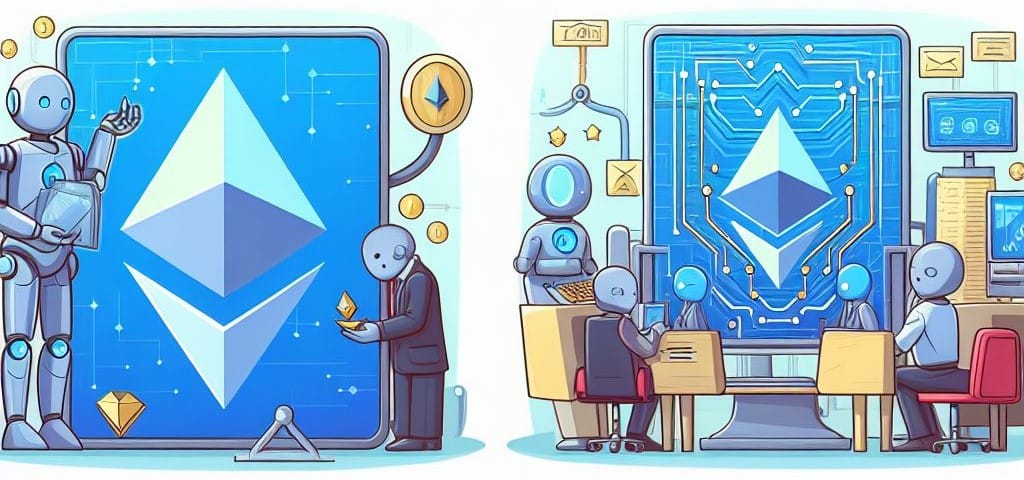The Web3 + AI Newsletter 14

Hello, everyone, and warm welcome to all newly joined subscribers!
This is the Web3 + AI newsletter, where we explore the intersection of blockchain and artificial intelligence. It has been a week of EthDenver updates, skyrocketing cryptocurrency prices, and loads of infrastructure and research advancements. We are once again in the midst of a bull market and the excitement in the air is almost palpable! Luckily, the building doesn't stop, which is evident by the several different approaches to optimizing AI computations on-chain presented below.
Thank you for being here! Let's dive in!
What's New in the Web3 + AI Startup World?
Ritual Partners with EigenLayer, io.net
Ritual, the sovereign and community-owned AI network I told you about in one of my first newsletters, announced two high-impact partnerships this week. First, it teamed up with EigenLayer, currently the largest ETH re-staking protocol in existence, to build AI-powered dApps (decentralized applications). Moreover, the partnership will create new streams of revenue for EigenLayer operators, who will be incentivized to power AI computations.
According to Ritual, its first product, Infernet, will be the first to enable smart contracts to access AI models cost-efficiently and natively. The integration will develop new Actively Validated Services (AVS) to power Ritual’s infrastructure and enable graphics processing unit (GPU)-capable EigenLayer restakers to serve decentralized inference, fine-tuning and proving in its on-chain economy.
We’re pioneering several new Actively Validated Services (AVS) as part of this partnership: 1) AI Model Operations via EigenLayer Operators, 2) Economic Security for our Proof Marketplace, and 3) Model Routing Services.
Ritual is currently building AI-native computational capabilities into blockchains through its AI coprocessor. Learn more about it below.

Then, Ritual allied with io.net to employ their decentralized computation network and to make it “easy and cost-efficient for developers and protocols to integrate AI into their on-chain workloads”. By taking advantage of their strong synergy, the two companies target to reach new developers and markets and to enhance GPU utilization and AI progress.

Arweave Launches Hyper-Parallel Computer AO
The decentralized storage network Arweave presented AO, a hyper-parallel computer for unlimited computation. AO can execute any number of large-scale computation operations simultaneously while also preserving their verifiability. Thus, it introduces unprecedented scaling and optimization as compared to other decentralized computation systems.
In its core, AO is an open and flexible data protocol for the storing of computation logs on the Arweave permanent ledger.
The base layer of AO aims to do for computing what the Internet protocol did for data transmission. Offer a standardized, open mechanism that suits all kind of use cases.

Unlike traditional blockchain design, where a global shared state is pursued, AO enables an unlimited number of parallel processes to happen which then coordinate by sending messages between each other. Arweave as an on-chain storage system that can scale to arbitrary sizes, serves as the base layer and permanent host for all these processes.
As a result, AO allows for Large Language Models (LLMs), recommendation systems, and indexers to run inside smart contracts.
AO has been in beta for a few weeks, which means some early projects have already been built. The team at Arweave India produced Orbit, an oracle system for AO that allows a user to pull an entire webpage into a smart contract for processing, which would give access to broader financial information.

Modulus Releases Fastest ZKML Prover Remainder
As you can see, the race to bring AI on-chain is getting tighter! Amid all the projects competing in the ZKML category, Modulus Labs seems to be getting ahead with the release of Remainder, the world's most powerful ZKML prover.
Since AI models are too computationally intensive to be run on top of a blockchain, mechanisms like zero-knowledge machine learning (ZKML) or optimistic machine learning (opML) are used to verify AI operations and guarantee tamper-resistance. However, although it offers higher levels of security, ZKML is usually too computationally expensive, which makes it impractical.
Not for long, though. Modulus' Remainder currently offers “180x overhead (as compared to naive AI inference on the same CPU hardware)”, enormous progress to the overhead of between 10,000x and 100,000x recorded a year ago. Learn more and give Remainder a try below.

Ora Introduces opp/ai Combining ZKML & opML
And since I promised loads of infra & research news, here is one more in the realm of AI verifiability. Ora Protocol, the creator of the On-chain AI Oracle OAO, has launched opp/ai, a novel framework for optimistic privacy-preserving AI on-chain unifying ZKML and opML.
The framework integrates Zero-Knowledge Machine Learning (zkML) for privacy with Optimistic Machine Learning (opML) for efficiency, creating a hybrid model tailored for blockchain AI services.

The objective of opp/ai is to balance the trade-off between ZKML's privacy protection and opML's computational efficiency. The framework allows for small concessions in privacy in exchange for significantly reduced cryptographic overhead. What it ultimately achieves is to enable the Ethereum blockchain to run any model.
Check out the research paper here and let me know what you think.

GameSwift Enters the DePIN Game
The modular zkEVM-based and gaming-dedicated blockchain, GameSwift adds decentralized computation to its service offer. In a strategic move following the massive DePIN trend, the platform empowers gamers to lend their idle computing resources to AI operations.

All gamers need to do to participate is download GameSwift's latest app GS-Force AI. Up to 85% of the revenue generated through leasing compute will go back to the hardware owners, as the remaining 15% will be reserved for the GS Pay stakers.

io.net's GPUs to Power Nuklai's Data Marketplace
Another DePIN news from the Nuklai team, who continues onboarding compute infrastructure networks. After it integrated GPU.net last week, it now moves on to io.net's GPU clusters, aimed at introducing resilience by providing various compute options.
Nuklai’s infrastructure will help io.net create private data networks to monetize their data. Furthermore, Nuklai’s community of data enthusiasts and curators will enhance io.net’s data with metadata, turning it into fuel for AI and LLMs.


Noteworthy Podcasts, Articles, Events
Giannis Rousopoulos on the Convergence of AI and DAOs
This week, I had the pleasure of welcoming another guest writer to my Web3 + AI blog, namely Giannis Rousopulos! Giannis has rich experience in the world of crypto, especially in aspects like institutional relations, education, and mentorship. If you have missed his piece on the myriad benefits of converging AI and DAOs (decentralized autonomous organizations), make sure to check it below.

Mistral Under Suspicion After Partnering with Microsoft
The AI lab Mistral made the headlines this week after announcing a partnership with tech behemoth Microsoft. Although there is nothing surprising in such a move from a business perspective, and there is probably no other path to growth for the French start-up, it still arose righteous indignation amid Mistral's extensive lobbying against the EU AI Act.
/cdn.vox-cdn.com/uploads/chorus_asset/file/24347780/STK095_Microsoft_04.jpg)
France was one of the most vocal opponents of introducing stricter AI regulation on a European level, citing the protection of its local hero Mistral as its central argument. Ultimately, Mistral did manage to gain exemptions from many of the AI Act's obligations concerning foundation models builders, aimed at preserving its competitiveness vis-à-vis American counterparts.
Now, Green MEPs are asking whether there wasn't a conflict of interest, and more particularly: were negotiations with Microsoft ongoing at the time Mistral was pushing for softer EU rules? If, yes, were French authorities aware? Luca Bertuzzi lists all the relevant questions, but it is still not clear who will give the answers:


Disclaimer: None of this should or could be considered financial advice. You should not take my words for granted, rather, do your own research (DYOR) and share your thoughts to create a fruitful discussion.








